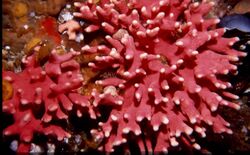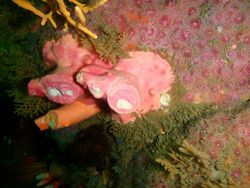Biology:Stylaster nobilis
| Stylaster nobilis | |
|---|---|

| |
| Scientific classification | |
| Domain: | Eukaryota |
| Kingdom: | Animalia |
| Phylum: | Cnidaria |
| Class: | Hydrozoa |
| Order: | Anthoathecata |
| Family: | Stylasteridae |
| Genus: | Stylaster |
| Species: | S. nobilis
|
| Binomial name | |
| Stylaster nobilis Stechow, 1921
| |
Stylaster nobilis, the noble coral, is a branching colonial hydroid in the family Stylasteridae.[1]
Description
Noble corals are pink or orange and tree-like with paler tips to the colony's branches. The calcareous colonies may grow to over 25 cm in total height, while individual polyps are 0.1 cm in diameter.[2] There is no free medusa stage.
The polyps project from star-shaped cavities in the rigid calcareous skeleton. Growth occurs at the tips and on the outside surface, which gradually thickens and which may show concentric rings in section.
Colour and shape variation
Distribution
This colonial animal is found only off the South African coast from the Atlantic Coast of the Cape Peninsula to Port Elizabeth in 5-100m of water. It is endemic to this region.[2]
Ecology
Noble corals feed on plankton and resemble hard corals. They occur in cool temperate waters usually in caves and under overhangs. They are very slow-growing: large colonies may be over 100 years old. A permit is required to collect these animals.[2]
Synonyms
The following species are considered synonyms of Stylaster nobilis:[1]
- Allopora explanata Kent, 1871
- Allopora nobilis Kent, 1871
- Allopora ochracea Qulech, 1884
References
Wikidata ☰ Q2844836 entry










